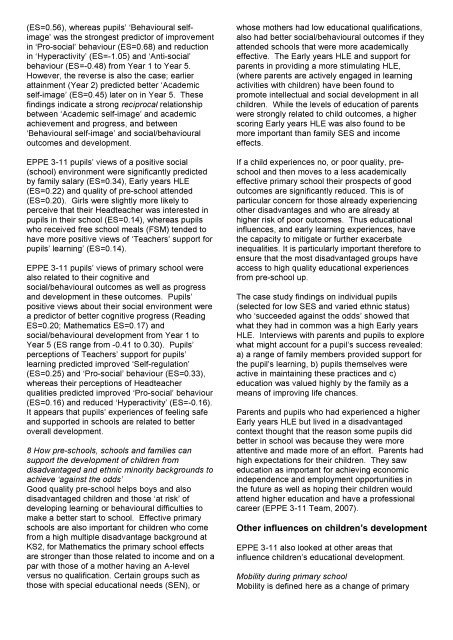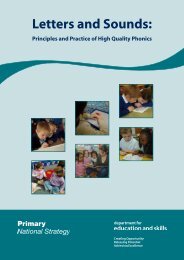Research Brief - Department for Education
Research Brief - Department for Education
Research Brief - Department for Education
Create successful ePaper yourself
Turn your PDF publications into a flip-book with our unique Google optimized e-Paper software.
(ES=0.56), whereas pupils’ ‘Behavioural selfimage’<br />
was the strongest predictor of improvement<br />
in ‘Pro-social’ behaviour (ES=0.68) and reduction<br />
in ‘Hyperactivity’ (ES=-1.05) and ‘Anti-social’<br />
behaviour (ES=-0.48) from Year 1 to Year 5.<br />
However, the reverse is also the case; earlier<br />
attainment (Year 2) predicted better ‘Academic<br />
self-image’ (ES=0.45) later on in Year 5. These<br />
findings indicate a strong reciprocal relationship<br />
between ‘Academic self-image’ and academic<br />
achievement and progress, and between<br />
‘Behavioural self-image’ and social/behavioural<br />
outcomes and development.<br />
EPPE 3-11 pupils’ views of a positive social<br />
(school) environment were significantly predicted<br />
by family salary (ES=0.34), Early years HLE<br />
(ES=0.22) and quality of pre-school attended<br />
(ES=0.20). Girls were slightly more likely to<br />
perceive that their Headteacher was interested in<br />
pupils in their school (ES=0.14), whereas pupils<br />
who received free school meals (FSM) tended to<br />
have more positive views of ‘Teachers’ support <strong>for</strong><br />
pupils’ learning’ (ES=0.14).<br />
EPPE 3-11 pupils’ views of primary school were<br />
also related to their cognitive and<br />
social/behavioural outcomes as well as progress<br />
and development in these outcomes. Pupils’<br />
positive views about their social environment were<br />
a predictor of better cognitive progress (Reading<br />
ES=0.20; Mathematics ES=0.17) and<br />
social/behavioural development from Year 1 to<br />
Year 5 (ES range from -0.41 to 0.30). Pupils’<br />
perceptions of Teachers’ support <strong>for</strong> pupils’<br />
learning predicted improved ‘Self-regulation’<br />
(ES=0.25) and ‘Pro-social’ behaviour (ES=0.33),<br />
whereas their perceptions of Headteacher<br />
qualities predicted improved ‘Pro-social’ behaviour<br />
(ES=0.16) and reduced ‘Hyperactivity’ (ES=-0.16).<br />
It appears that pupils’ experiences of feeling safe<br />
and supported in schools are related to better<br />
overall development.<br />
8 How pre-schools, schools and families can<br />
support the development of children from<br />
disadvantaged and ethnic minority backgrounds to<br />
achieve ‘against the odds’<br />
Good quality pre-school helps boys and also<br />
disadvantaged children and those ‘at risk’ of<br />
developing learning or behavioural difficulties to<br />
make a better start to school. Effective primary<br />
schools are also important <strong>for</strong> children who come<br />
from a high multiple disadvantage background at<br />
KS2, <strong>for</strong> Mathematics the primary school effects<br />
are stronger than those related to income and on a<br />
par with those of a mother having an A-level<br />
versus no qualification. Certain groups such as<br />
those with special educational needs (SEN), or<br />
whose mothers had low educational qualifications,<br />
also had better social/behavioural outcomes if they<br />
attended schools that were more academically<br />
effective. The Early years HLE and support <strong>for</strong><br />
parents in providing a more stimulating HLE,<br />
(where parents are actively engaged in learning<br />
activities with children) have been found to<br />
promote intellectual and social development in all<br />
children. While the levels of education of parents<br />
were strongly related to child outcomes, a higher<br />
scoring Early years HLE was also found to be<br />
more important than family SES and income<br />
effects.<br />
If a child experiences no, or poor quality, preschool<br />
and then moves to a less academically<br />
effective primary school their prospects of good<br />
outcomes are significantly reduced. This is of<br />
particular concern <strong>for</strong> those already experiencing<br />
other disadvantages and who are already at<br />
higher risk of poor outcomes. Thus educational<br />
influences, and early learning experiences, have<br />
the capacity to mitigate or further exacerbate<br />
inequalities. It is particularly important there<strong>for</strong>e to<br />
ensure that the most disadvantaged groups have<br />
access to high quality educational experiences<br />
from pre-school up.<br />
The case study findings on individual pupils<br />
(selected <strong>for</strong> low SES and varied ethnic status)<br />
who ‘succeeded against the odds’ showed that<br />
what they had in common was a high Early years<br />
HLE. Interviews with parents and pupils to explore<br />
what might account <strong>for</strong> a pupil’s success revealed:<br />
a) a range of family members provided support <strong>for</strong><br />
the pupil’s learning, b) pupils themselves were<br />
active in maintaining these practices and c)<br />
education was valued highly by the family as a<br />
means of improving life chances.<br />
Parents and pupils who had experienced a higher<br />
Early years HLE but lived in a disadvantaged<br />
context thought that the reason some pupils did<br />
better in school was because they were more<br />
attentive and made more of an ef<strong>for</strong>t. Parents had<br />
high expectations <strong>for</strong> their children. They saw<br />
education as important <strong>for</strong> achieving economic<br />
independence and employment opportunities in<br />
the future as well as hoping their children would<br />
attend higher education and have a professional<br />
career (EPPE 3-11 Team, 2007).<br />
Other influences on children’s development<br />
EPPE 3-11 also looked at other areas that<br />
influence children’s educational development.<br />
Mobility during primary school<br />
Mobility is defined here as a change of primary
















